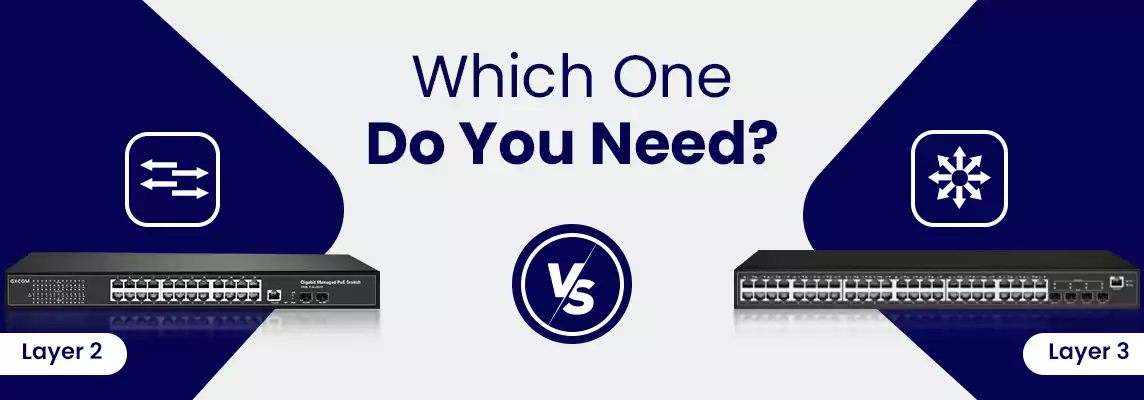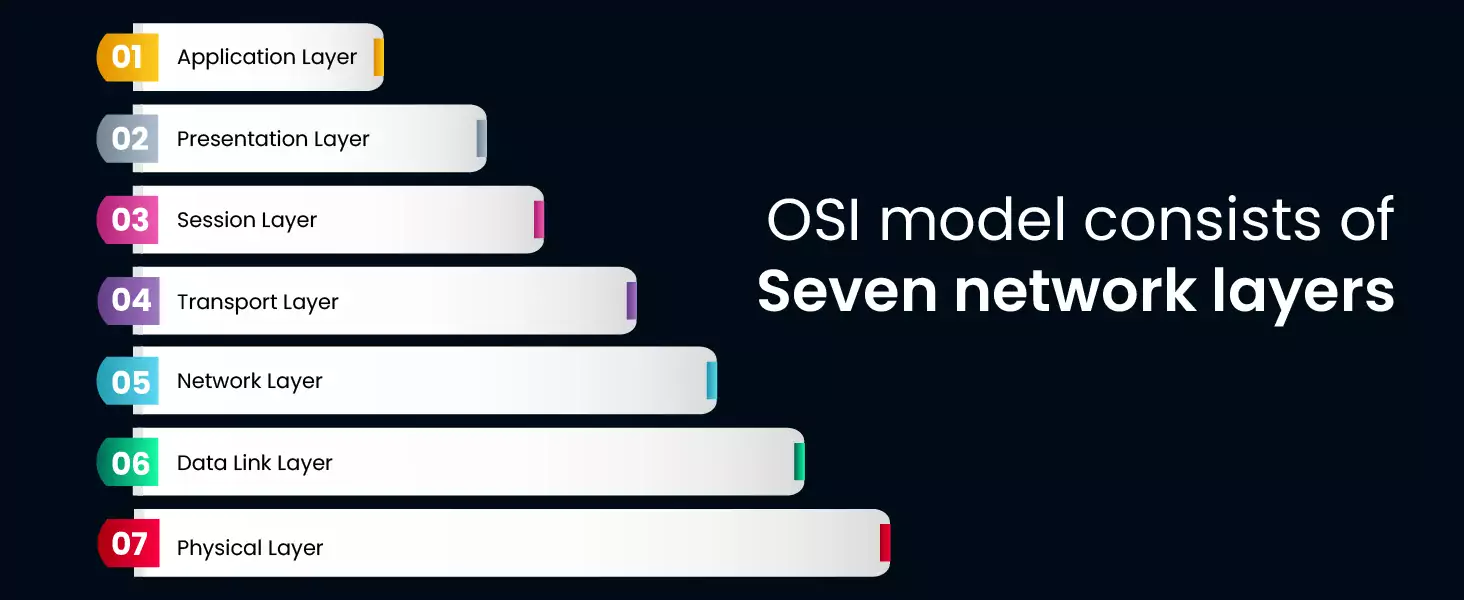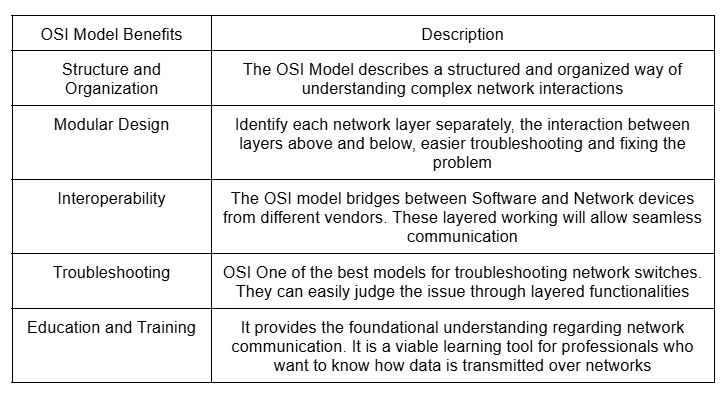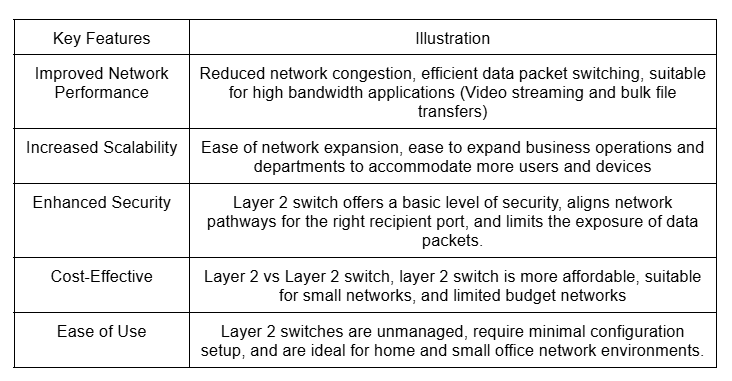Network Switch — Layer 2 Vs Layer 3: Which One Do You Need
Network Switch — Layer 2 Vs Layer 3: Which One Do You Need

Ethernet Cables are the physical channels that bridge between different network devices to transfer data between computers, printers, modems, and network switches. But are you familiar with the network switch, OSI model, and the Layer 2 vs Layer 3 switches? I am sure you do but let’s discuss it further to cultivate its benefits, working, and the key components of layer 2 and layer 3 switches.
Based on the OSI model, the layer 2 switch is dependent on the Data Link Layer and on the other hand, the layer 3 switch is dependent on the network layer. But all this information generates a question about which is the most prominent Network Switch — Layer 2 vs Layer 3. Go through this blog to learn in-depth knowledge about Network Layers.
What is a Network Switch?
A Network Switch is a hardware device connecting devices on a computer network. The operation of network switches correlated with the layer 2 switch (Data Link Layer) of the Open Systems Interconnection (OSI Model). It acts in the form of a Traffic Cop for data packets regarding your network.
In technical terms, the Network Switch is named the Switching Hub, MAC Bridge, and Bridging Hub standardized by IEEE (Institute of Electrical and Electronics Engineers). Besides, the Network Switch — a multiport network bridge that utilizes MAC (Media Access Control) address to proceed data towards the Data Link Layer (Layer 2 Switch) of the Open Systems Interconnection model. Moreover, some switches use routing protocols to transfer data to Layer 3 and are commonly referred to as Layer 3 Switches or Multilayer switches. There are some key functions of the network switch that are as follows:
- Connectivity — a network switch allot ease to connect various devices like printers, computers, servers, and other switches. All these interconnections will allow them to share information more efficiently.
- Packet Switching — Network switches are an enhanced technology in networking that opposes the older networking devices “Hub”. It does not simply broadcast the Data Packets but first reads the path and transfers it to its intended destination.
- Learning and Forwarding — The switching hub uses an alternate technique “Mapping” to transfer the data packets at the right path. Once the data travels to the network switch it maintains the record and assigns the location of the device. This improves data transmission.
- Collision Reduction — once the data packets are moved forward to the destination here come the switches that reduce collisions that happen in Hubs. This collision reduction improves network performance.
Benefits of Network Switches
- Improved Network Performance
- Increased Scalability
- Enhanced Security
- Reduced Network Congestion
- Pathway for the Data Packets
What is the OSI Model and Its Benefits?
The OSI model refers to network architecture (Open Systems Interconnection Model). This model is a conceptual framework that dictates the network communication system. It breaks down the complex concept of how a network works. The OSI model consists of seven network layers that depict communication functions.

The OSI model, also known as the Open Systems Interconnection model, is a conceptual framework that defines network communication. It's a standardized reference model that acts like a common language for understanding how data travels across a network.
There are several benefits of the OSI Model that are listed below:

Besides all these benefits, there are some additional benefits of the OSI Model to enhance your knowledge regarding network communication.
- Standardization — The Open Systems Interconnection (OSI Model) creates a mid-reference point for developing and communicating networks.
- Vendor Independence — It reduces the dependency on different vendors however, promotes an open networking communication environment.
- Scalability — you can easily add new technology and functionality to the existing network.
What is Layer 2 Switch?
A Layer 2 Switch operates on a data link layer of the OSI model that translates and forwards data packets through MAC addresses. It is mostly used for small networks and also it eliminates the need for frame networking and works within the hardware layer.
The core functionality of the layer 2 switch includes packet switching (Aligning signals to their intended destination), learning and forwarding (Mapping MAC addresses to their ports), and collision reduction (Managing the network congestion to a minimum). We see layer 2 switch associated with the workgroup connectivity and network segmenting.

What is Layer 3 Switch?
Layer 3 Switch is also referred to as the multilayer switch. This network device integrates the processing of Layer 2 Switch and data routing capabilities. The operation of the Layer 3 switch combines the OSI model's Data Link Layer and Network Layer. Creates a seamless process to manage advanced traffic as compared to the standard Layer 2 Switch. Besides routing, the layer 3 switch is also used to route data packets to their target destination and deliver advanced features of Virtual LAN traffic tag according to IP addresses, increasing capacity, security, and ability to manage network traffic.
|
Key Attributes |
Description |
|
Routing |
Can route Data Packets (Network Segments Subnets), Eliminate the dedicated router need, simple network management, and reduce hardware requirements |
|
Packet Forwarding (IP Addresses) |
Uses IP addresses (Layer 3 Header Data Packets), Intelligent routing decisions, destination network subnet |
|
Improved Network Performance |
Efficient traffic routing within the network, reduces network congestion, |
|
Scalability |
Suitable for growing networks, can add additional networking technology, handle traffic loads |
|
Security Features |
Basic security features (ACLs) Access Control Lists |
|
Advanced Features |
VLAN (Virtual LAN) and QoS (Quality of Service) for allocating bandwidth for desired applications |
The Difference between Layer 2 Vs Layer 3 Switches
Layer 2 switches and Layer 3 switches are kind of different and to know the difference in depth below is the explanation between Layer 2 vs Layer 3 switches.
|
Attributes |
Layer 2 Switch |
Layer 3 Switch (Multiple Switch) |
|
OSI Model |
Layer 2 Switch (Data Link) |
Layer 2 and Layer 3 (Data Link and Network) |
|
Routing Capability |
Unable to route between Subnets (Limited) |
Eligible to route traffic between subnets |
|
Network Size |
Suitable for small networks |
Mostly for larger networks with multiple subnets |
|
Complexity |
Simple and easy to manage |
Advanced configuration is required for this complex network |
|
Cost |
Affordable |
Expensive |
|
Typical use cases |
Connection between different devices and subnets |
Routing traffic between subnets, dividing VLAN networks, Improving security and performance (QoS and ACL) |
|
Additional Features |
Limited |
Offer Virtual LAN, ACL, and QoS |
|
Scalability |
Less scalable |
More scalable to add other networking technologies |
|
Example |
Home network switch |
Managed switch for enterprise network |
What Types of Switches are Suitable For Your Network?
The network switch, Layer 2 vs Layer 3 switch can be chosen according to the dependability of the network complexity and the size. Here is a quick guide regarding the need for a network switch depending on the network environment.
- Choose a Layer 2 Switch When
- You are dealing with a small network with a minimal number of devices.
- All devices are connected with the same subnets.
- You require a simple and easy connectivity networking solution.
- Choose a Layer 3 Switch When
- Dealing with larger networks along with multiple subnets.
- Need routing option for different network segments.
- You need a stable and improved performance and scalability
- Advanced features like VLAN and QoS to allocate the bandwidth.
In a Nutshell
This blog has briefly explained the Network Switch, the OSI model, and the difference between Layer 2 vs layer 3 switch and their benefits. This is precise and to-the-point information and a mixture of technical aspects regarding the network switch usage.
I hope you will like the guide and also go through our other technical blogs, and guides regarding the networking cables. Smartech Cables dealing in ethernet cables and accessories always wishes to provide you with the best and proper guidance about LAN cables and accessories.


